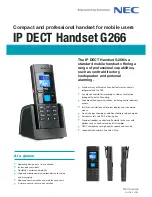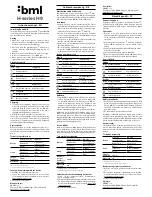
CRYSIS 2 Bluetooth Headset
For PlayStation®3
For:
PL-6385
Thank you for purchasing the Crysis 2 Bluetooth Headset for
Playstation 3®!
Contents
1 Crysis 2 Bluetooth Headset for Playstation 3®
1 Power Cord
Charging the Battery
1) Open the flap covering the connector port on the Crysis 2 Bluetooth Headset for Playstation 3®.
2) Connect the mini USB end of the power cord to the connector port on the Crysis 2 Bluetooth Headset for Playstation 3.
3) Connect the USB end of the power cord to a USB port on the Playstation 3.
4) When connected to the power cord and charging, the LED on the Crysis 2 Bluetooth Headset for Playstation 3 will light up solid
red.
5) When connected to the power cord and fully charged, the LED on the Crysis 2 BluetoothHeadset for Playstation 3 will light up
solid blue.
Powering the Crysis 2 Bluetooth Headset for Playstation 3® ON and OFF
1) To power ON the Crysis 2 Bluetooth Headset for Playstation 3®, press and hold the power button for about 3 seconds. The LED on
the Crysis 2 Bluetooth Headset for Playstation 3 will blink red 3 times.
2) To power OFF the Crysis 2 Bluetooth Headset for Playstation 3®, press and hold the power button for about 3 seconds. The LED on
the Crysis 2 Bluetooth Headset for Playstation 3® will blink red 2 times.
Pairing the Crysis 2 Bluetooth Headset with the Playstation 3®
1) Power your Playstation 3® OFF for about 10 seconds and then power it back ON.
2) Select Access Settings on the Playstation 3® Settings menu.
3) Select Register Bluetooth Device.
4) Select Manage Bluetooth Device.
5) Select Yes to register a new device, if this is the first time registering a Bluetooth device.
6) Select Start Scanning.
7) Hold down the Power Button on Bluetooth headset for 6 seconds.
8) When prompted for a pass key, enter 0000.
9) For quick disconnection, press the Power Button once to disconnect it from the Playstation 3®, and again to re-connect.
Pairing the Crysis 2 Bluetooth Headset with Bluetooth Compatible Device
1) Follow the intructions for the Bluetooth Handheld Device concerning pairing with a Bluetooth Headset. Verify that the Crysis 2
Bluetooth Headset for Playstation 3® is powered ON. When prompted for a pass key, enter 0000.
2) LED indication: Standby unconnecting with mobilephone: red LED will blink once every 3 seconds.
Standby connecting with mobilephone: red LED will blink twice every 3 seconds.
Talking: red LED will blink twice every 5 seconds.
Adjusting the Microphone Input Levels on the Playstation 3®
1) To adjust your microphone input levels on the Playstation 3®, go to the Audio Device Settings Menu on your Playstation 3® and
select the Bluetooth Handheld Device.
Adjusting the Volume Level on the Crysis 2 Bluetooth Headset with the Playstation 3®
1) To adjust the volume level on the Crysis 2 Bluetooth Headset for Playstation 3®, use the vol + button to increase the sound level,
and the vol – button to decrease the sound level.
Using the Mute Button on the Crysis 2 Bluetooth Headset
1) To mute the microphone level on the Crysis2 Headset for Playstation 3*, press and hold the vol+button for 3 seconds. To return
the microphone level to normal, press and hold the vol+ button for 3 seconds.
Adjusting the Earloop on the Crysis 2 Bluetooth Headset
1) If your prefer to wear the Crysis 2 Bluetooth Headset for Playstation 3® on your left ear, gently remove and flip over the earloop 180
degrees. Gently snap the earloop back onto the Crysis 2 Bluetooth Headset for Playstation 3 and rotate it into position.
© 2011 Performance Designed Products LLC. All rights reserved. PDP is a trademark of Performance Designed Products LLC. The Bluetooth® word mark and logos are registered trademarks owned by Bluetooth SIG, Inc.
and are used under license by PDP. All other brand names are trademarks or registered trademarks of their respective owners. PlayStation 3 is a registered trademark of Sony Computer Entertainment, Inc. This product
is not designed, manufactured, sponsored or endorsed by Sony. This product is manufactured under license from Crytek GmbH. The computer game Crysis 2 is intellectual property of Crytek GmbH © 2011. Crytek® ,
Crysis® and certain characters of Crysis 2 are registered trademarks or trademarks or design patents of Crytek GmbH in Germany, USA and other countries.
For technical questions please visit
www.pdp.com or call: 1-800-331-3844 (USA ONLY)
1840 East 27th Street
Vernon, CA 90058 USA
CBX II - 382-390 Midsummer Blvd.,
Milton Keynes, Buckinghamshire MK9 2RG UK
Warning: Extended exposure
to high volumes when using a
headset may result in temporary
or permanent hearing loss.
CAUTION:
Changes or modifications to this equipment not expressly approved by the manufacturer could
void the users authority to operate the equipment.
This equipment has been tested and found to comply with the limits for a Class B digital device, pursuant
to part 15 of the FCC Rules. These limits are designed to provide reasonable protection against harmful
interference in a residential installation. This equipment generates, uses and can radiate radio frequency
energy and, if not installed and used in accordance with the instructions, may cause harmful interference
to radio communications. However, there is no guarantee that interference will not occur in a particular
installation. If this equipment does cause harmful interference to radio or television reception, which can be
determined by turning the equipment off and on, the user is encouraged to try to correct the interference
by one or more of the following measures:
—Reorient or relocate the receiving antenna.
—Increase the separation between the equipment and receiver.
—Connect the equipment into an outlet on a circuit different from that to which the
receiver is connected.
—Consult the dealer or an experienced radio/TV technician for help.
FCC ID: X5B-PL6385
This device complies with FCC radiation exposure limits set forth for an uncontrolled environment and
it also complies with Part 15 of the FCC RF Rules and RSS-210 of the IC Rules. Operation is subject to the
following two conditions:
(1) this device may not cause harmful interference, and
(2) this device must accept any interference received, including interference that may
cause undesired operation.
























